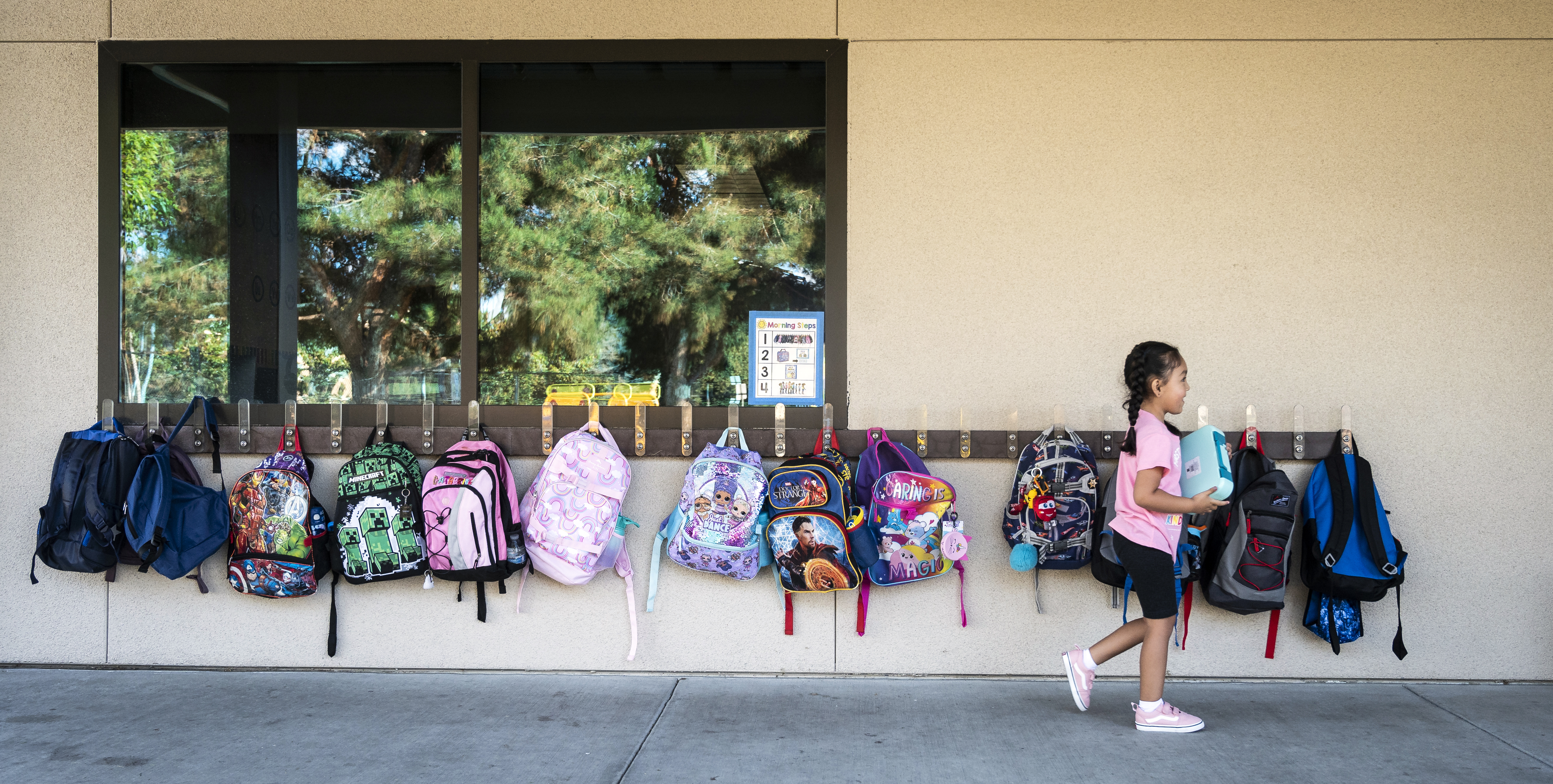
School District Mission Statements Highlight a Partisan Divide Over Diversity, Equity and Inclusion in K-12 Education
Table of Contents
Table of Contents
Table of Contents
In recent years, K-12 education has emerged as a political flash point in American society. Lawmakers in numerous states have proposed laws that limit what educators can say in the classroom about topics like race or gender identity – even as other states have mandated greater emphasis on these topics. And a recent Pew Research Center survey found widespread partisan divisions in the topics that parents of K-12 students across the country believe are appropriate for children to learn about in school.
A new content analysis by the Center of 1,314 mission statements from public school districts across the country finds these same themes playing out in how school districts themselves describe their mission in educating students.
School district mission statements form the core operating principles of educational institutions across the United States. These documents provide a set of unifying goals for the different schools operating under the same district administration. They seek to give clarity to the district’s beliefs and values, as well as the steps they are taking to uphold their broader educational vision. As such, they provide a valuable tool for examining how school districts across the country view their own role and approach to educating and caring for the students they serve.
For this content analysis, researchers from the Center first assembled a representative sample of 1,500 regular public school districts from a comprehensive list maintained by the National Center for Education Statistics. Then, they found the website for each school district and searched the site for any documents that “define and reflect the district’s role in education and its prioritized goals for educating students.” This process identified 1,314 mission statements for which sufficient information about the district itself could be found to facilitate the analysis. These 1,314 documents make up the basis of this study.
Two researchers were assigned to code the collected mission statement texts based on whether or not they mentioned certain broad topics of interest (such as the strength of their academic programs or a safe and healthy environment for students). This analysis also used pointwise mutual information to identify distinctive terms related to these topics.
For more on how this study was conducted, read the full Methodology.
These mission statements present a wide range of educational commitments and priorities. They most commonly emphasize preparing students for their futures after graduation: 80% of all mission statements mention this issue, which might include goals such as college and job readiness, developing lifelong learners and creating productive citizens.
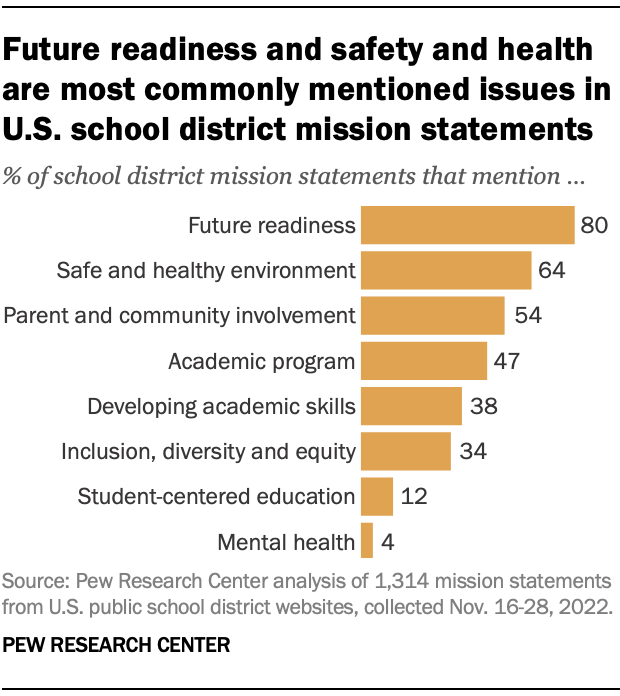
Around two-thirds of mission statements (64%) mention the importance of providing a safe, nurturing and healthy environment for students. Just over half (54%) mention the need for parent and community involvement in the districts’ educational efforts. Somewhat smaller shares focus on the academic programs the district offers (47%) or the importance of developing academic skills such as problem-solving or analytical and critical thinking (38%).
Other topics are far rarer. Just 12% of these documents refer to providing a student-centered education. And although parents cited mental health as a top concern in a recent survey, just 4% of mission statements explicitly mention improving the mental health of students as a core educational function.
Overall, 34% of school districts highlight the importance of diversity, equity and inclusion efforts in their mission statements. This is much lower than the share of districts that mention topics like future readiness or providing a safe and healthy environment. But in contrast to these subjects, there is much more variation across the country in whether school districts mention issues related to diversity and equity in their mission statements at all.
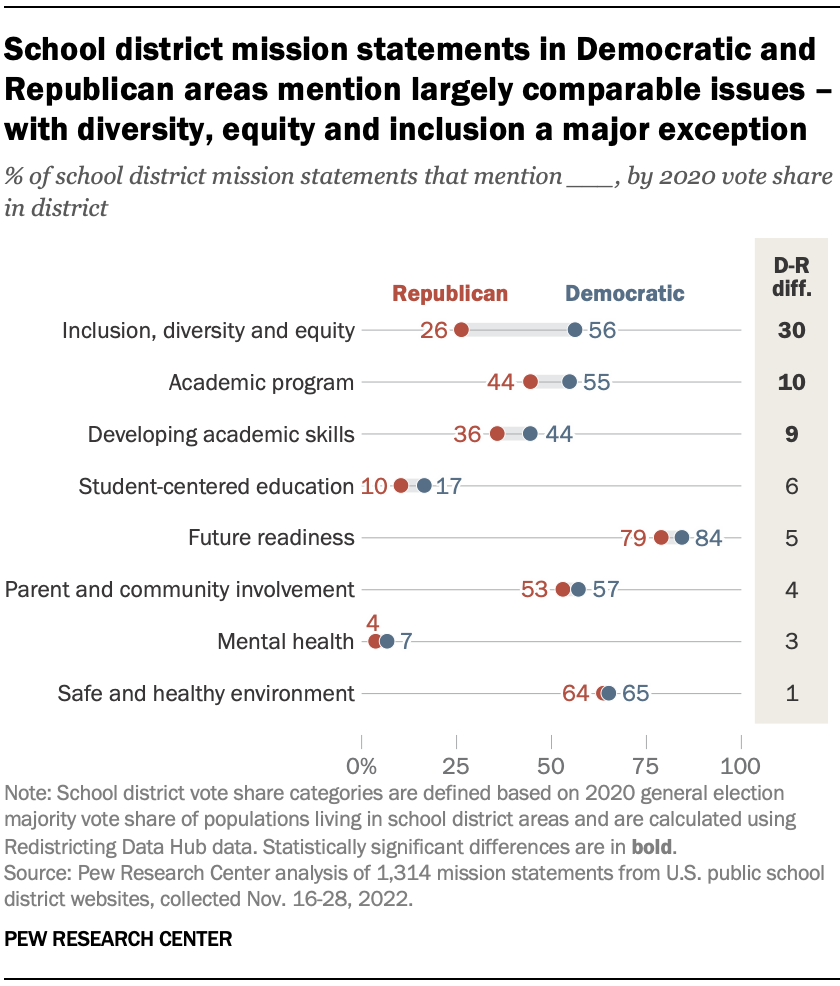
Consider, for instance, the mission statements of schools in Republican or Democratic districts – where the majority of residents voted for Donald Trump or Joe Biden, respectively, in the 2020 presidential election. Similar shares of districts in each group mention topics like the future readiness of their students, providing a safe and healthy educational environment, or including parents and the community in their educational efforts.
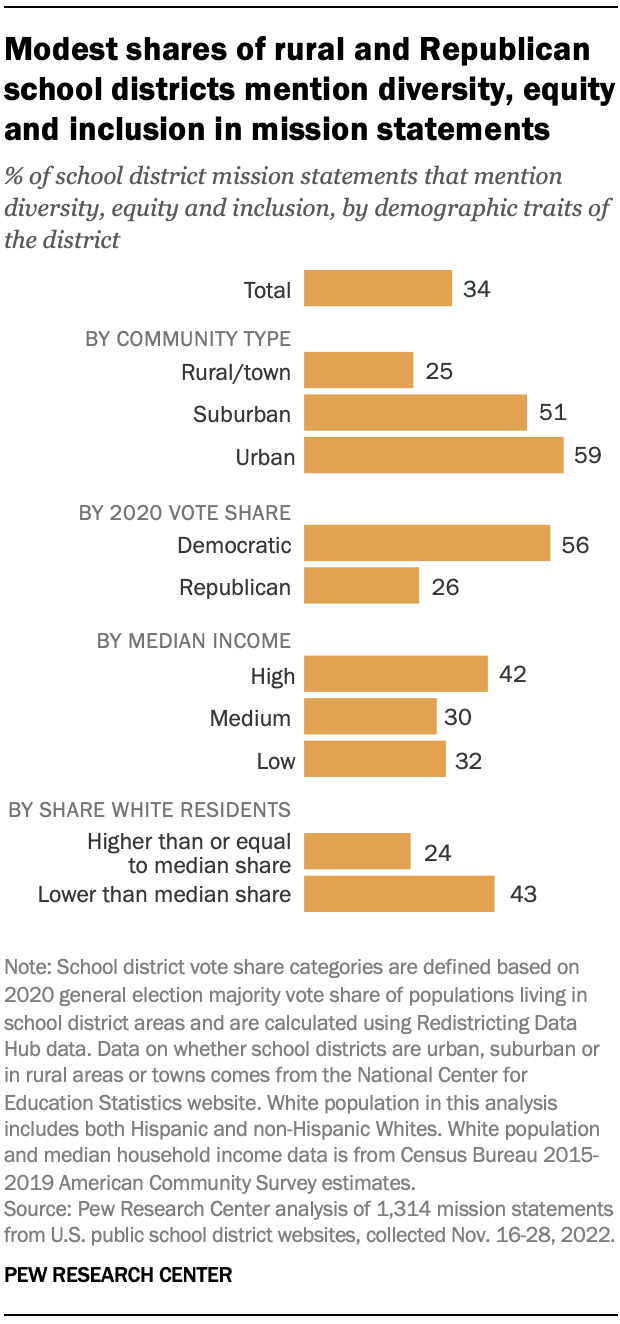
By contrast, a 56% majority of districts in Democratic-voting areas mention their diversity, equity and inclusion efforts in their mission statements. That is true of just 26% of districts in Republican-voting areas, a difference of 30 percentage points.
This trend – diversity, equity and inclusion standing apart from the relative consistency with which other topics are mentioned – also holds true across other demographic traits of school districts. Most notably, urban and suburban school districts are at least twice as likely as those in rural areas to mention this issue. (Nine-in-ten rural districts in this analysis are located in areas that voted Republican in the 2020 general election, compared with 41% of suburban and 31% of urban districts.) Diversity-related topics are also more common in school district mission statements from areas with relatively high median incomes, as well as areas with a lower proportion of White residents.
How language varies across school district mission statements: A closer look
School mission statements vary widely in their length, content and complexity. The median document in this collection is 125 words in length. But the shortest is just five words and the longest is 1,691 words. Districts in non-rural areas tend to be more verbose in describing their missions. The median rural school district mission statement is 102 words long, but the median statements from urban and suburban districts use 189 and 172 words, respectively. And the median mission statement for school districts in Democratic-voting areas is also longer than the median district in Republican-voting ones (158 vs. 112 words).
In addition to categorizing the broad topical issues that are mentioned in school district mission statements, researchers from the Center examined the textual content of these statements. These findings offer nuance for how school districts across the country describe their mission in their own words. To conduct this analysis, the Center identified terms that are distinctive to each of the broader topical categories – that is, terms that are common in mission statements mentioning a particular topic (such as students’ future readiness or school safety) but relatively rare in those that do not.

How school districts discuss diversity: ‘Diversity’ and ‘culture’ mentioned more often than ‘equity’ and ‘inclusion’
Some of the most distinctive terms used to discuss diversity, equity and inclusion are “culture” and “diversity” – each of which is mentioned in around a quarter of all mission statements – along with “equity” and “inclusion,” each used in roughly one-in-ten mission statements.
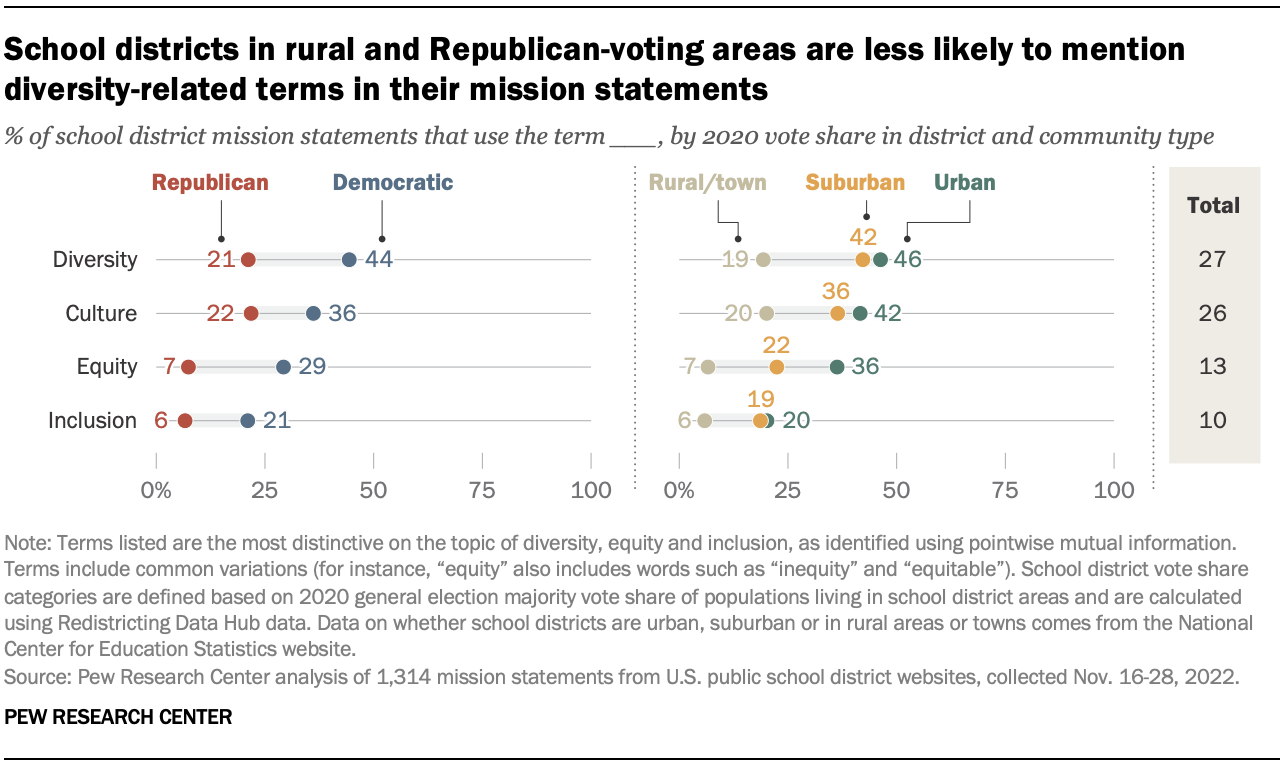
Comparatively modest shares of school district mission statements from rural and Republican-voting areas mention each of these four terms, in part because districts in these areas are less likely to mention the broad topic of diversity in general. At the same time, school districts in these areas are also less likely to use some of these terms even when discussing the issue of diversity in a general sense.
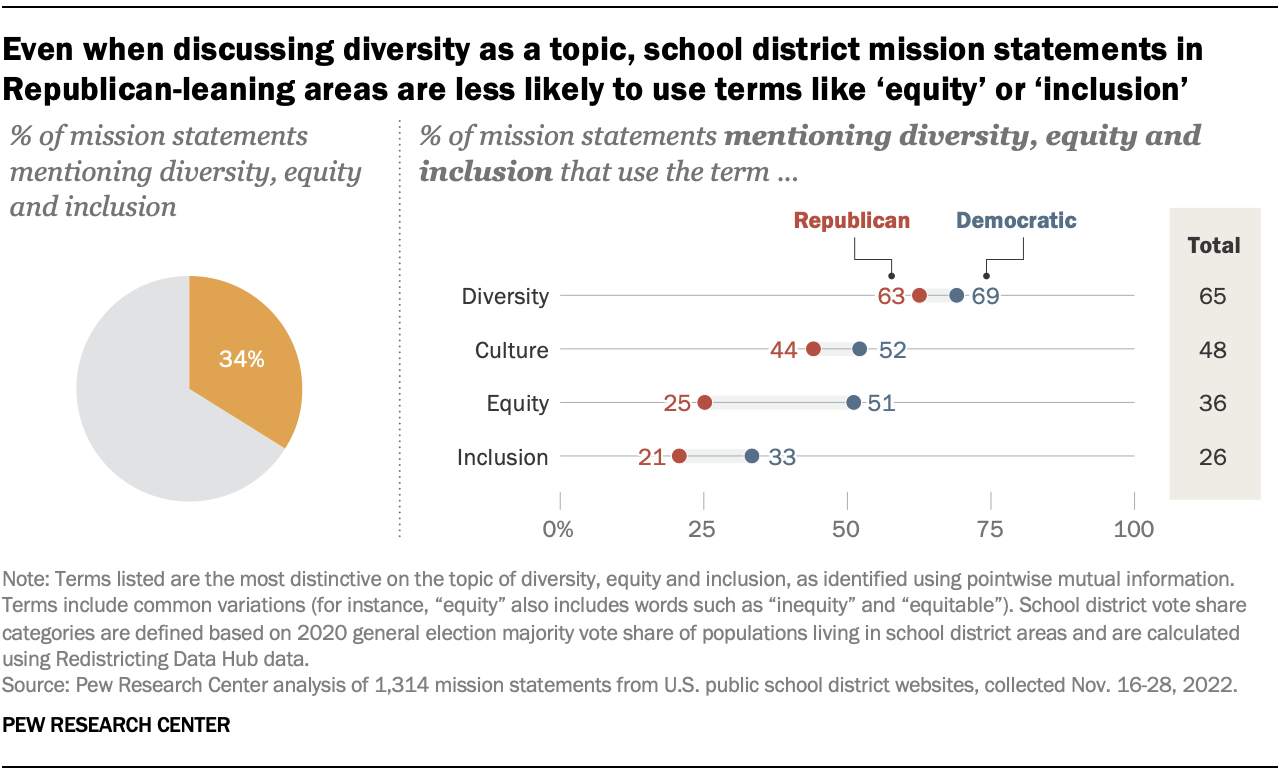
Direct mentions of race or origin are much less common: Only 3% of all mission statements use terms like “race” or variations on “closing [the achievement] gap,” and fewer than 1% of the documents mention “nationality.” However, the phrase “closing [the achievement] gap” is somewhat more common in school districts with a below-median share of White residents: 5% reference this term, compared with fewer than 1% of mission statements from districts with a larger share of White residents.
Within the subset of mission statements that mention diversity-related issues, comparable shares of school districts located in Democratic- and Republican-voting areas use terms like “diversity.” But those from Democratic-voting areas are more likely to mention terms like “equity” (51% vs. 25%), “inclusivity” (33% vs. 20%) and “closing [the achievement] gap” (11% vs. 3%).
“[S]tudents will become contributing citizens in a global society while respecting individual differences.”
Rural school district in a Republican-voting area
“The school staff will assist students in gaining mastery of the fundamental tools for learning so that the student will apply these skills to … develop respect for people of all races and nationalities, and cultivate an attitude which will enable the student to reconcile individual interests with the common good.”
Rural school district in a Republican-voting area
“Recognizing the value of diversity and being inclusive of differing cultures make our community strong.”
Urban school district in a Republican-voting area
School districts from Republican-voting areas less likely to mention social and emotional learning terms in mission statements
In addition to using diversity-related language in different ways, larger shares of school districts in Democratic-leaning areas than in GOP-leaning ones incorporate the language of social-emotional learning into their mission statements.
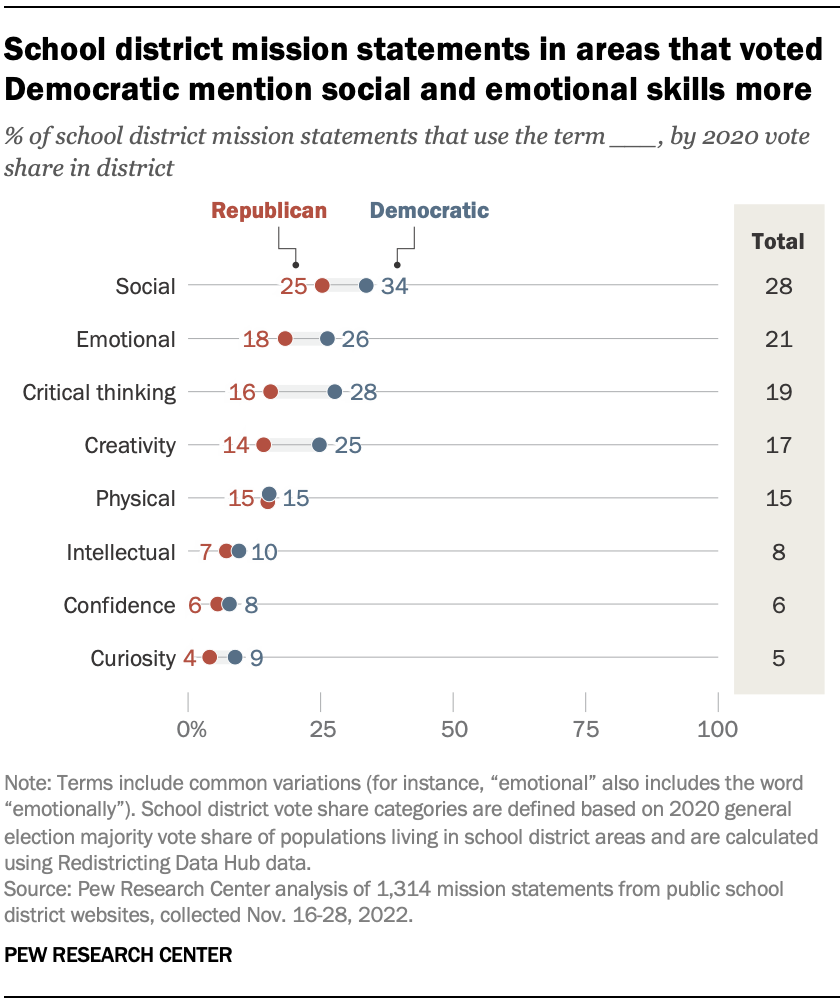
Social-emotional learning is an educational paradigm that stresses self-awareness, self-control and interpersonal skills as prerequisites for educational success. The concept has recently received extensive criticism from conservative groups, although a recent Pew Research Center survey shows that majorities of Democratic and Republican K-12 parents say it is very or extremely important to them that their children learn social and emotional skills at school.
Among all statements analyzed, around one-in-three school districts in Democratic-voting areas (34%) and 25% of those in Republican-voting districts use the term “social.” And larger shares of school districts in Democratic-voting areas use terms like “critical thinking” (28% vs. 16%) and “creativity” (25% vs. 14%). At the same time, nearly identical shares of each type of district use terms like “physical,” “intellectual” or “confidence.” Some of these terms (such as “critical thinking” or “creativity”) are also used more often in areas with a lower than median share of White residents, although these differences tend to be relatively modest.
“Social, physical, emotional and cognitive developments are recognized as factors which influence student learning.”
RURAL SCHOOL DISTRICT IN A REPUBLICAN-VOTING AREA
Each student is a valued individual with unique physical, social, emotional, and intellectual needs. Students need to develop a deep understanding of essential knowledge and skills.”
Urban school district in a Democratic-voting area
“Mission: Inspiring a love of learning in all students so they develop as critical thinkers and innovative creators who contribute to the world with integrity and purpose beyond themselves.”
Suburban school district in a Democratic-voting area
Future readiness: Raising ‘global’ citizens, preparing students for career or college
School districts across the country use a variety of distinctive terms to emphasize the rigor of their academic programs. For instance, 24% of all mission statements use the term “curriculum,” with no significant variation across school districts based on vote shares in their areas, or whether they are urban, suburban or rural districts. Another distinctive term related to academic rigor – “academic excellence” – is used relatively rarely but fairly consistently across district types.
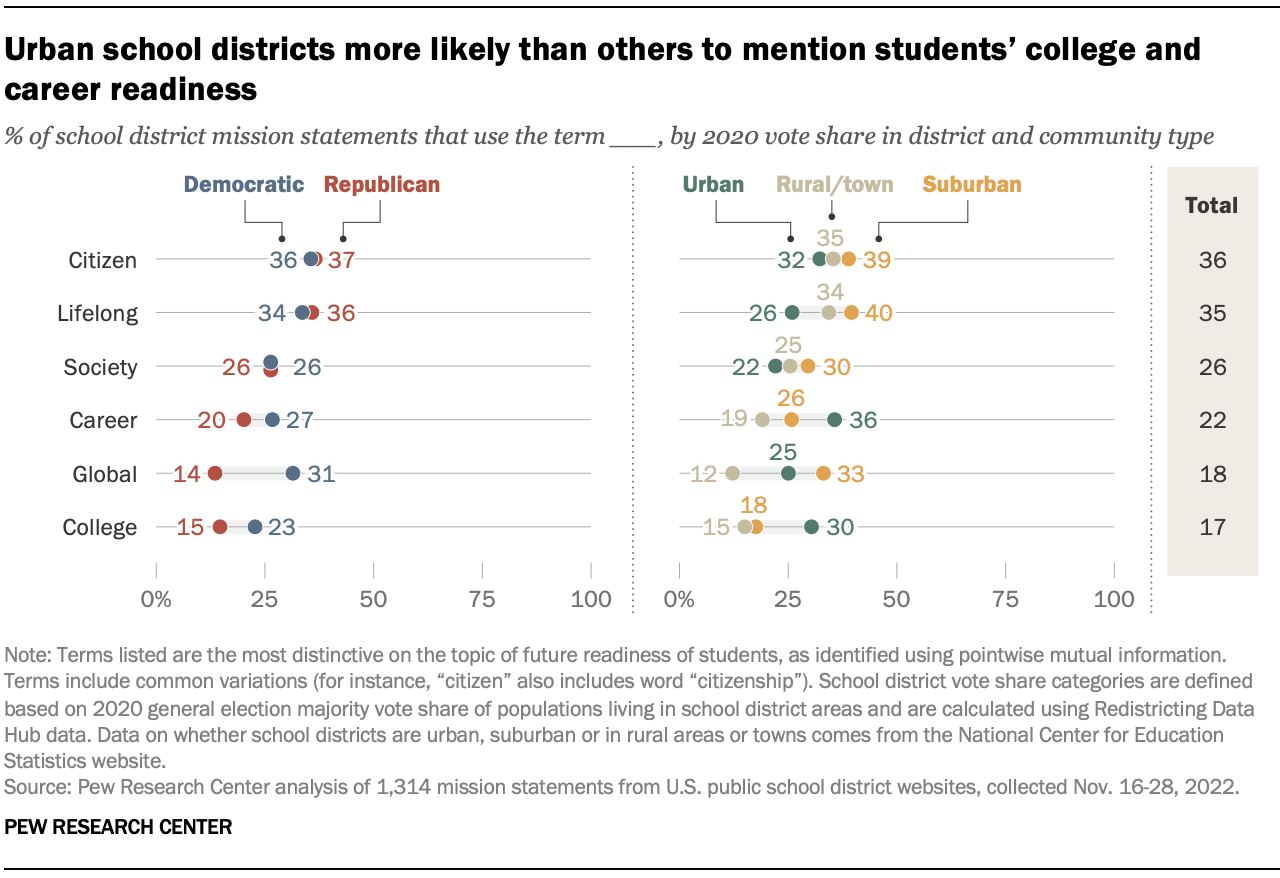
Other concepts related to individual student development vary more in usage. Terms like “citizen[ship],” “lifelong [learning],” “society,” “career,” “global” and “college” are among the most distinctive terms that deal with raising future-ready students. By and large, the mission statements of school districts in Democratic- and Republican-voting areas use these terms to describe the future readiness of their students.
But a key difference is in the term “global.” Some 31% of school district mission statements from Democratic-voting areas – but just 14% of those from GOP-voting districts – use this term, often in the context of students’ integration into global society. The word “global” is also more prevalent in mission statements of suburban school districts: One-third use the term, compared with a quarter of urban and 12% of rural districts.
Meanwhile, terms like “college” and “career” are especially common in the mission statements of urban districts. “Career” is used in 36% of urban school district mission statements, nearly double the share among rural districts (19%). “College” also appears in a larger share of urban school district mission statements (30%) than in suburban (18%) or rural (15%) areas. By contrast, a slightly smaller share of urban districts (26%) mention the concept of “lifelong” learning compared with those in suburban (40%) or rural (34%) areas.

Safe and healthy schools, parent and community involvement: How school districts discuss the schooling environment
The safety and health of the educational environment is the second-most frequently mentioned topic in school district mission statements, and half of all districts use the term “safe” in describing their mission. This comes at a time when about a third of K-12 parents are extremely or very concerned that a shooting could happen at their children’s school, and when many public schools are taking steps to tighten security on campus.
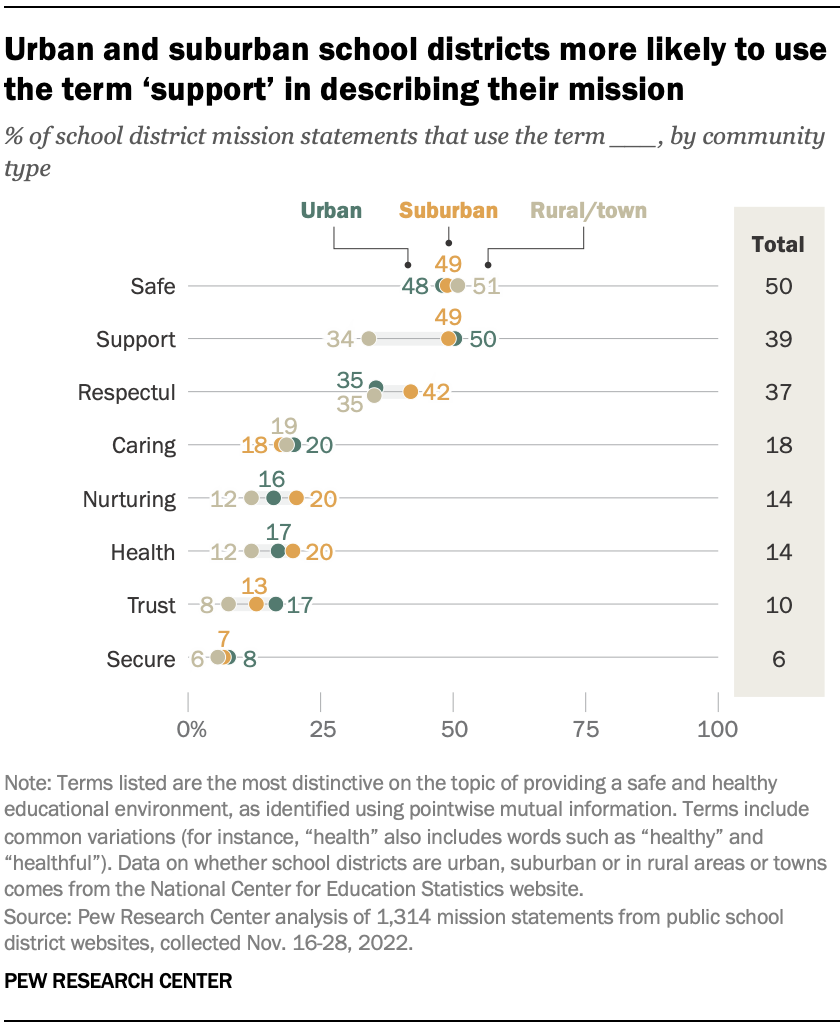
While “safe” and related terms like “secure” are used in similar shares of mission statements from school districts in urban, suburban and rural areas, there are notable differences in the use of health-related terms. For instance, the term “support” is used in half of both urban and suburban school district mission statements (50%), compared with 34% of those in rural areas. Similarly, “trust” appears in 17% and 13% of mission statements from urban and suburban school districts, respectively, versus 8% of those in rural areas.
Parent and community involvement in the educational process is another relatively common topic, mentioned in more than half of school district mission statements overall. And the distinctive terms “family” and “parent” each appear in more than a quarter of all mission statements. A larger share of school districts in Democratic areas use the term “family” relative to those in Republican areas (35% vs. 25%). But there are no such differences on terms like “parent,” “stakeholder” or “business.”
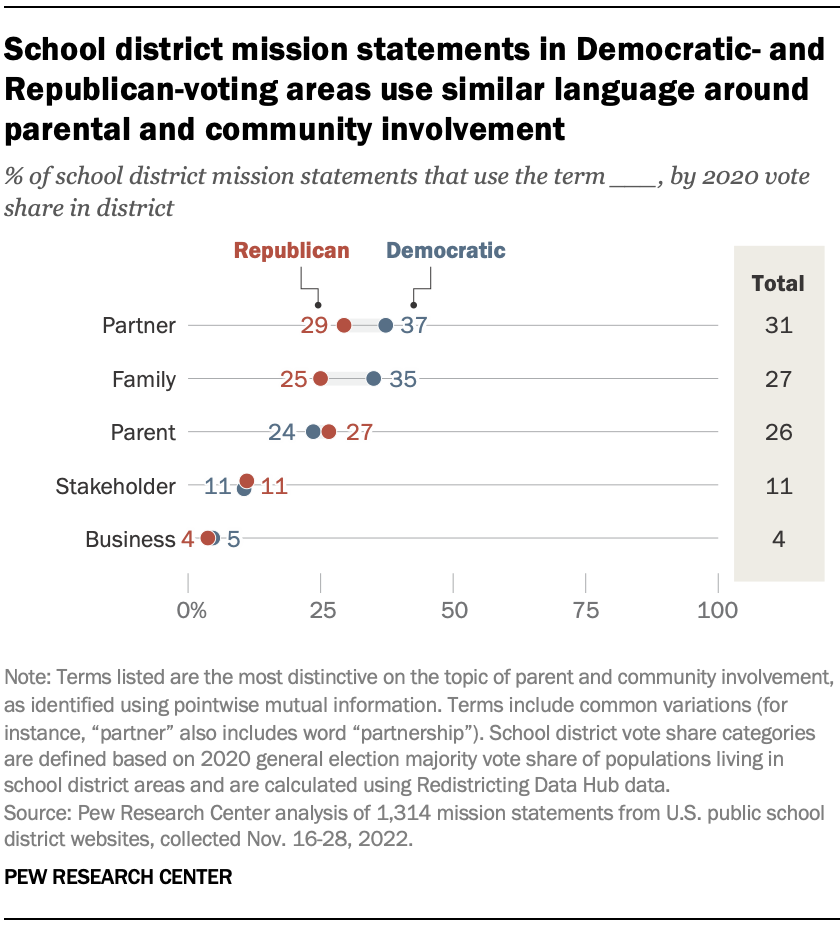
“Student learning will be enriched by cultivating family, community, and business partnerships.”
Rural school district in a Democratic-voting area
“We believe in open, non-judgmental communication with families, staff, students, and the community. … We believe in collaboration of schools, families, and the community to benefit the lives of children.”
Suburban school district in a Republican-voting area
About this essay
This essay benefited greatly from the work and thoughtful comments of many individuals at Pew Research Center. Nimisha Sharma, Eliza Smith and Henry Forteith collected and coded the school district mission statement data. Athena Chapekis contributed her expertise to developing the codebook. Gonzalo Rivero and Andrew Mercer provided invaluable suggestions on survey methodology, and Rakesh Kochhar gave his insights on using economic metrics for the analyses. Aaron Smith, Kim Parker and Juliana Horowitz provided editorial guidance. Graphics were created by Alissa Scheller, and Sara Atske handled digital production. David Kent offered extensive copy editing of the finished product, while Sono Shah conducted quality checks on the analysis and underlying code.
For details on how this analysis was conducted, read the full Methodology.
Lead photo by Paul Bersebach/MediaNews Group/Orange County Register via Getty Images